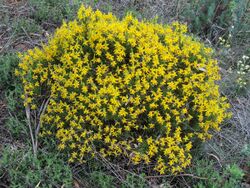Biology:Genistoids
| Genistoids | |
|---|---|

| |
| Genista hirsuta | |
| Scientific classification | |
| Kingdom: | Plantae |
| Clade: | Tracheophytes |
| Clade: | Angiosperms |
| Clade: | Eudicots |
| Clade: | Rosids |
| Order: | Fabales |
| Family: | Fabaceae |
| Subfamily: | Faboideae |
| Clade: | Meso-Papilionoideae |
| Clade: | Genistoids Wojciechowski et al. 2004[2][3] |
| Tribes[8][9] | |
| |
| Synonyms | |
| |
The Genistoids are one of the major radiations in the plant family Fabaceae. Members of this phylogenetic clade are primarily found in the Southern hemisphere.[2][8][9] Some genera are pollinated by birds.[8] The genistoid clade is consistently resolved as monophyletic in molecular phylogenetic analyses.[2][8][9][11][12][13][14][15] It is estimated to have arisen 56.4 ± 0.2 million years ago (in the Paleocene).[12] A node-based definition for the genistoids is: "the MRCA of Poecilanthe parviflora and Lupinus argenteus."[2] One morphological synapomorphy has been tentatively identified: production of quinolizidine alkaloids.[2][16][17][18] Some genera also accumulate pyrrolizidine.[8][9] A new genus, to be segregated from Clathrotropis, has also been proposed to occupy an undetermined position within the genistoid clade.[8][9]
Core Genistoids
The core genistoids, also known as the genistoids sensu stricto, comprise most of the tribes of the genistoids sensu lato, and are found mainly in Africa and Eurasia.[9] This subclade is also consistently resolved as monophyletic.[2][8][9][4][11][12][13] A node-based definition for the core genistoids is: "the MRCA of Bolusanthus speciosus and Spartium junceum."[2]
Systematics
Modern molecular phylogenetics suggest the following relationships:[5][7][9]
| |||||||||||||||||||||||||||||||||||||||||||||||||||||||||||||||||||||||||||||||
References
- ↑ "Fabales". https://mobot.org/MOBOT/research/APweb/orders/fabalesweb.htm.
- ↑ 2.0 2.1 2.2 2.3 2.4 2.5 2.6 "A phylogeny of legumes (Leguminosae) based on analysis of the plastid matK gene resolves many well-supported subclades within the family". Am J Bot 91 (11): 1846–1862. 2004. doi:10.3732/ajb.91.11.1846. PMID 21652332.
- ↑ Wojciechowski MF (2013). "Towards a new classification of Leguminosae: Naming clades using non-Linnaean phylogenetic nomenclature". S Afr J Bot 89: 85–93. doi:10.1016/j.sajb.2013.06.017.
- ↑ 4.0 4.1 "Molecular phylogeny of the genistoid tribes of papilionoid legumes". Advances in Legume Systematics, Part 9. Royal Botanic Gardens, Kew. 2000. pp. 249–276. ISBN 978-1842460177. http://www.kewbooks.co.uk/asps/ShowDetails.asp?id=52.
- ↑ 5.0 5.1 "A molecular-dated phylogeny and biogeography of the monotypic legume genus Haplormosia, a missing African branch of the otherwise American-Australian Brongniartieae clade". Molecular Phylogenetics and Evolution 107: 431–442. 2017. doi:10.1016/j.ympev.2016.12.012. PMID 27965083.
- ↑ "Oberholzeria (Fabaceae subfam. Faboideae), a New Monotypic Legume Genus from Namibia". PLOS ONE 10 (3): e0122080. 2015. doi:10.1371/journal.pone.0122080. PMID 25816251. Bibcode: 2015PLoSO..1022080S.
- ↑ 7.0 7.1 "A settled sub-family for the orphan tree: The phylogenetic position of the endemic Colombian genus Orphanodendron in the Leguminosae". Brittonia 69: 1–9. 2016. doi:10.1007/s12228-016-9451-3.
- ↑ 8.0 8.1 8.2 8.3 8.4 8.5 8.6 "Revisiting the phylogeny of papilionoid legumes: new insights from comprehensively sampled early-branching lineages". Am J Bot 99 (12): 1991–2013. 2012. doi:10.3732/ajb.1200380. PMID 23221500.
- ↑ 9.0 9.1 9.2 9.3 9.4 9.5 9.6 9.7 "Reconstructing the deep-branching relationships of the papilionoid legumes". S Afr J Bot 89: 58–75. 2013. doi:10.1016/j.sajb.2013.05.001.
- ↑ Polhill RM (1981). "Papilionoideae". Advances in Legume Systematics, Parts 1 and 2. Royal Botanic Gardens, Kew. pp. 191–208. ISBN 9780855212247. http://www.kewbooks.com/asps/ShowDetails.asp?id=318.
- ↑ 11.0 11.1 LPWG [Legume Phylogeny Working Group] (2013). "Legume phylogeny and classification in the 21st century: progress, prospects and lessons for other species-rich clades". Taxon 62 (2): 217–248. doi:10.12705/622.8. https://www.zora.uzh.ch/id/eprint/78167/1/Taxon_2013_217-248.pdf.
- ↑ 12.0 12.1 12.2 "Evolutionary rates analysis of Leguminosae implicates a rapid diversification of lineages during the tertiary". Syst Biol 54 (4): 575–94. 2005. doi:10.1080/10635150590947131. PMID 16085576.
- ↑ 13.0 13.1 "Phylogenetic supermatrix analysis of GenBank sequences from 2228 papilionoid legumes". Syst Biol 99 (12): 1991–2013. 2006. doi:10.1080/10635150600999150. PMID 17060202.
- ↑ "Phylogenetic relationships of basal papilionoid legumes based upon sequences of the chloroplast trnL intron". Syst Bot 55 (5): 818–836. 2001. doi:10.1043/0363-6445-26.3.537. http://www.bioone.org/doi/abs/10.1043/0363-6445-26.3.537.
- ↑ "A phylogeny of the chloroplast gene rbcL in the Leguminosae: taxonomic correlations and insights into the evolution of nodulation". Am J Bot 84 (4): 541–554. 1997. doi:10.2307/2446030. PMID 21708606.
- ↑ "Alkaloid distribution in seeds of Ormosia, Pericopsis and Haplormosia". Phytochemistry 27 (2): 439–444. 1988. doi:10.1016/0031-9422(88)83116-9.
- ↑ Van Wyk B-E. (2003). "The value of chemosystematics in clarifying relationships in the Genistoid tribes of papilionoid legumes". Biochem Syst Ecol 31 (8): 875–884. doi:10.1016/S0305-1978(03)00083-8.
- ↑ "Evolution of chemical defense traits in the Leguminosae: mapping of distribution patterns of secondary metabolites on a molecular phylogeny inferred from nucleotide sequences of the rbcL gene". Biochem Syst Ecol 31 (8): 897–917. 2003. doi:10.1016/S0305-1978(03)00085-1.
Wikidata ☰ Q18343763 entry
 |
